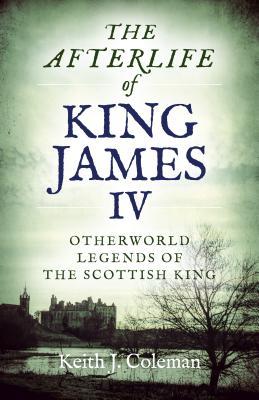 The Afterlife of King James IV explores the survival stories following the Scottish king’s defeat at the Battle of Flodden in 1513 and how his image and legacy were used in the years that followed, when he remained a shadow player in the politics of a shattered kingdom.
The Afterlife of King James IV explores the survival stories following the Scottish king’s defeat at the Battle of Flodden in 1513 and how his image and legacy were used in the years that followed, when he remained a shadow player in the politics of a shattered kingdom.
Coleman has written a legend-based biography of James IV that straddles the gap between history and folklore and looks at the undying king motif and otherworld myths of James IV, one of Scotland’s most successful rulers.
‘Afterlife’ is a departure from the vast array of royal biographies that history lovers have available at their finger tips. This book is concentrated on the notoriety and popularity of King James IV both before and after his death. The main focus of the book is the myriad of folklore, myth and legends that arose following the king’s death in September of 1513 together with the more traditionally accepted version of what happened to the king following the battle.
King James IV appears to be regarded as one of the most successful Stuart monarchs despite his relatively short reign, defeat and subsequent death at the Battle of Flodden. The book begins by setting out the relationship of James IV with his father, James III, the details surrounding the demise of his father following an uprising for which, it is said, that James IV felt profound guilt. Legend has it that as a result James wore an iron chain around his waist for the rest of his life and added to the links each year as a physical penance for his perceived guilt.
Once James IV is proclaimed king, Keith Coleman asserts that his reign, compared to that of his father, ‘seems like the light following darkness’ and it appears that James ably commanded his realm, seeking to ‘involve all classes of Scots in his leadership’. It is asserted that his skilled diplomacy provided Scotland with a higher profile abroad. His subsequent marriage to Margaret Tudor (daughter of Henry VII) united the crowns of England and Scotland with the Treaty of Perpetual Peace. It was such achievements as these and the king’s perceived charisma which would contribute to his legacy, and, when the time came, the reluctance of his people to believe that their king was dead.
Trouble arose for James when war broke out between England and France. As an ally to both countries, he was placed in a difficult position. However, he ultimately led an army south into Northumberland and during the battle of Flodden was killed alongside many other Scottish nobles. Flodden is still considered today as one of the worst Scottish defeats in military history, however, this is not where James’s story ends. Keith Coleman recounts two portentous events that are said to have taken place weeks before the fateful battle, the Vision in the Kirk and the Summons of Pluto which were said to signify supernatural opposition to the proposed military action by Scotland against the English. The two events which are described in thorough detail in chapter two, laid a heady foundation for the myths and legends that would follow James to his grave, wherever that grave might be.
There are many differing accounts as to what happened to James following the battle. The generally accepted story is that his body was recovered from the battlefield and brought to England where it lay undisturbed at the Abbey of Sheen for some considerable time. Sometime after the Reformation, the embalmed body was lost. Despite various rumours circulating to this day concerning the treatment of his body and his possible final resting place in London, none have ever been substantiated. Of course, it is entirely possible that he did die in battle and was buried in Scotland.
An alternative theory is that James survived the battle and went into exile, possibly undertaking a crusade to the Holy Land which is something he had previously considered during his reign. However, there appears to be no evidence to support this theory and there are apparently no recorded sightings of James after the Battle of Flodden.
Another hypothesis is that James was betrayed and brutally murdered by the third Lord Home (a Scottish nobleman who fought at the Battle of Flodden and was one of the noblemen who managed to escape with his life) and secretly buried somewhere in Scotland. This possibility was re-ignited when, during the 18th Century a skeleton was discovered when the well at Hume Castle was drained for maintenance works. It was said that the skeleton wore a chain similar to that favoured by James IV.
Keith Coleman takes each possibility in turn, weighing it with the writings, reports and beliefs of the times, allowing the reader to consider each possibility in turn. Ultimately, it appears we will never know exactly what happened, unlike the case of Richard III. However, the way in which the supernatural elements of the stories are woven together with the available facts, makes this an intriguing book to read. As someone who is not knowledgeable about the characters of the court at the time, I found I needed to occasionally stop to educate myself on the key players in the story. There are also some interesting parallels with the court of King Henry VIII, which bleed into the story from time to time.
Whilst the folklore and tales recounted are not necessarily wholly fiction, this book bridges the gap between hard non-fiction and fiction, is a pleasure to read and is an education for those wishing to build on their knowledge of Scottish history.
Reviewed by Kate Hope















Latest Comments